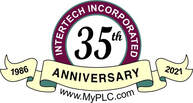Modicon Quantum Controller
Maintenance & Troubleshooting
Module 101
Maintenance and troubleshooting of the Quantum programmable control system provides a thorough understanding of the hardware and software aspects of the system. This course is designed to assist you with the necessary knowledge to troubleshoot and maintain your automation system. Quantum system hardware layout, installation and configuration are covered along with basic programming concepts. The Modicon Quantum Automation series programmable automation controller with its local, remote and distributed Input/Output systems are included in this four (4) day course.
Course Objectives
· Understand the major functional components of the Quantum programmable automation controller system as it relates to your facilities installation.
· Configure and layout a Quantum system including input/output modules, local, remote and distributed input/output system.
· Understand system addressing; inputs, outputs, input registers, output/holding registers and the input/output drop configuration requirements.
· Comprehend communication methods including Modbus serial, Modbus Plus local area network, ethernet and wireless networks with the additional implications of security.
· Number formats for discrete, analog, binary, binary coded decimal as these relate to the Modicon PAC.
· Discuss various field input/output devices such as contacts, relays, limit switches, LED displays, thumbwheels, transducers and temperature monitoring and their relationship to the control system.
· Learn to build and test basic control circuits involving relays, timers, counters, and calculate functions.
· Learn how to document and add long and short comments to your program for future reference.
· Read and write existing programs to and from your PAC to your PC or system storage media.
· Learn to use the built-in features of the software as a system diagnostic troubleshooting tool to identify and pinpoint faults in the control system.
· Identify the types of communication interface modules; RIO Heads and Drops and NOM, Network Option Modules and how they affect the performance of the system.
· Distinguish between hardware, software, and field related problems to isolate the problem to determine the course of action.
· Disassemble, reassemble, and start up a controller from dim awareness.
· Discuss, demonstrate, and test important safety considerations related to your programmable control system.
· Understand what the LED indicator lights on each module are representing and their importance for correct system troubleshooting.
· The differences between the computing systems for the Quantum and the 984 family of controllers is also covered.
Course Objectives
· Understand the major functional components of the Quantum programmable automation controller system as it relates to your facilities installation.
· Configure and layout a Quantum system including input/output modules, local, remote and distributed input/output system.
· Understand system addressing; inputs, outputs, input registers, output/holding registers and the input/output drop configuration requirements.
· Comprehend communication methods including Modbus serial, Modbus Plus local area network, ethernet and wireless networks with the additional implications of security.
· Number formats for discrete, analog, binary, binary coded decimal as these relate to the Modicon PAC.
· Discuss various field input/output devices such as contacts, relays, limit switches, LED displays, thumbwheels, transducers and temperature monitoring and their relationship to the control system.
· Learn to build and test basic control circuits involving relays, timers, counters, and calculate functions.
· Learn how to document and add long and short comments to your program for future reference.
· Read and write existing programs to and from your PAC to your PC or system storage media.
· Learn to use the built-in features of the software as a system diagnostic troubleshooting tool to identify and pinpoint faults in the control system.
· Identify the types of communication interface modules; RIO Heads and Drops and NOM, Network Option Modules and how they affect the performance of the system.
· Distinguish between hardware, software, and field related problems to isolate the problem to determine the course of action.
· Disassemble, reassemble, and start up a controller from dim awareness.
· Discuss, demonstrate, and test important safety considerations related to your programmable control system.
· Understand what the LED indicator lights on each module are representing and their importance for correct system troubleshooting.
· The differences between the computing systems for the Quantum and the 984 family of controllers is also covered.
Technical Education Is The Key That Unlocks The Door To Improved Communications Throughout Your Organization
|
© 1986 - 2019 Intertech Incorporated. All rights reserved.
|
| ||


